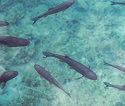 Sponsored by Rebel. America’s national parks hold some of the country’s most coveted fishing territory. Many of these parks’ streams and lakes—rife with rainbow, cutthroat, and brown trout among other native and non-native species—are inaccessible to anglers without the use of barbless lures.
Sponsored by Rebel. America’s national parks hold some of the country’s most coveted fishing territory. Many of these parks’ streams and lakes—rife with rainbow, cutthroat, and brown trout among other native and non-native species—are inaccessible to anglers without the use of barbless lures.
But why do national parks insist upon barbless lures?
The National Park Service’s ultimate goal is to protect and preserve natural ecosystems. The parks promote the catch-and-release method as a means of conservation and management. Some parks mandate the catch-and-release of certain species to allow fish to grow and reproduce, ultimately giving anglers a larger, healthier selection. The barbless lure rule has been adopted to reduce handling time and injury and to improve the overall condition of fish populations, especially in heavily fished waters.
National parks have been playgrounds for anglers since the early settlers. Over the years, many lakes and rivers were stocked with non-native species of trout to boost the sport. Our forefathers didn’t recognize that introducing non-native species of fish, animals, and plants can severely impact or even devastate native species. It wasn’t until the 1970s that serious efforts began to restore native species and remove non-native or exotic fish from the parks.
Today, quantity and size restrictions give fish time to mature and reproduce. Often, parks set the limit at 10 fish, even though many state laws allow 25. Regardless of the number, all anglers still feel that competitive urge to “catch the limit.” The best way to improve the sport of fishing for a limit of 10 is to use barbless lures. Barbless lures won’t harm the fish, and any caught after 10 may be thrown back.
While there are stricter catch-and-release policies for native species, some harvest regulations recently have been relaxed. To reduce predation, competition, and hybridization pressure on arctic grayling and cutthroat trout, Yellowstone National Park now encourages anglers to kill non-native brown and rainbow trout in areas where they cohabit with the native species.
These regulations are designed to preserve and restore the parks’ species and waters. Park visitors play an important role in conservation by carefully following fishing regulations. By supporting the catch-and-release method, anglers ensure that the joy of fishing our nation’s plentiful, pristine waters will be experienced by future generations.
